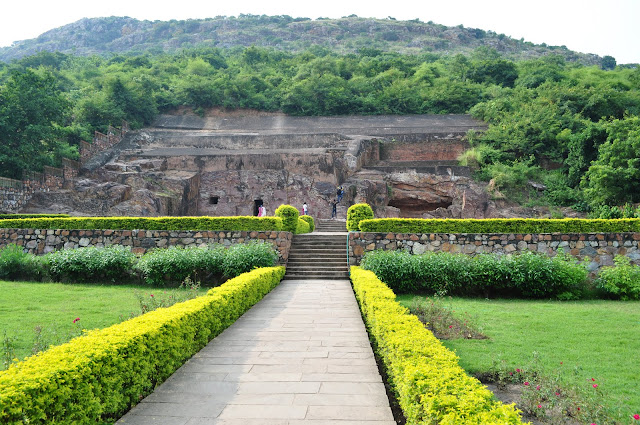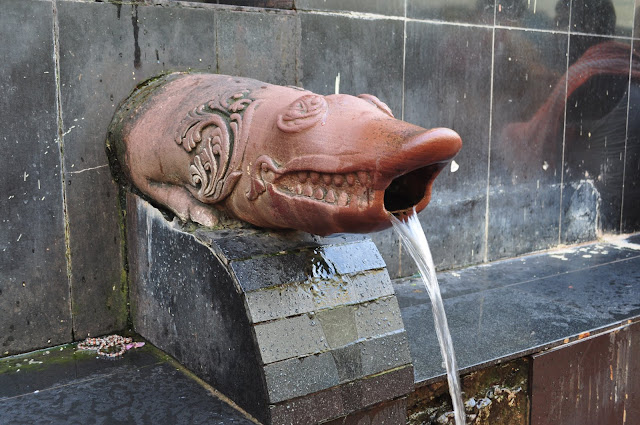World's most prestigious and thriving university of Ancient India. It was a childhood dream come true to visit this magnificent first International Residential University that flourished for centuries. A center of learning and way to means for people who were in search of wisdom. People from across the globe flocked to this university in India to graduate in Astronomy, Math, Grammar, Logic, Theology, Meta Physics and Medicine. It is said that the library of Nalanda continuously burnt for three months and that the smoke was seen from far away distances. Despite the savage destruction left behind by the Mughal invaders they failed to wipe away the memory and learning that this place offered. This proves "Pen is mightier than the sword."
An archway of massive thick green trees welcome you to this esteemed site. The ruins of Nalanda comprises of several monasteries, residential quarters, temples and shrines. The entire complex is mesmerizing that beyond any doubt in its heydays, Nalanda university would have given the best of education to people from across the globe. It is sad to see such a glorious historic monument now in ruins. We stood there baffled thinking about millions of Indians who stand for several hours in long queues outside embassies of foreign countries in the hope of getting admission in colleges overseas. There was a time when we gave the World good quality education and now for several years India has been facing a brain drain crisis.
Almost all of the many monuments, temple and monasteries are breathtaking. As we entered the ruins, to our left was monastery 3, the post card of Nalanda University- the most imposing of all and was constructed in seven phases. There were four towers erected on the corners of which only two remain now. You can walk around this monument and on the other side are several pagodas and small stupa like structures. Parallel to this is another monument in ruins that showcases state of the art water harvesting system.
Backtrack the same route and the pathway leads to the remaining temples and monasteries. Almost every monastery has residential cells, raised platforms for the teachers to preach while some of them are equipped with wells and traditional ovens used for cooking.The drainage system and the well thought of ventilation shafts for sunlight are commendable.
Monastery 1 apart from providing the maximum number of artifacts during excavation is one monastery that went through nine phases of construction. It has bed platforms and shelves for keeping books and other valuables. The destruction of the University by fire is visible in the cells of this monastery.
There is one monastery with vast number of stone pillars still standing in their original position serving more the purpose of a grand hall. Stay on the walkway and you will be led to the huge smelting furnace. Also, watch out for the small narrow passage that leads you to the temple and with this the tour of Nalanda pretty much comes to an end.
However, when you are existing the complex do not walk back the same route but take the trek path from the last temple shrine that leads you to the backside of all the monasteries. The highlight of this path is the elevated platform that offers breathtaking panoramic views of the ruins and also leads you to the most incredible ruin i.e. Temple no.2. Take a stroll around this temple to witness some of the most stunning and crisp stone carvings, portraying sculptures of gods and goddesses, Jataka stories, geometric patterns and even mermaids. Either our ancestors were big fans of fantasy or actually saw this for real. There are several pillars lying around this temple and each paints a unique story.
Sarai Mound concludes your visit to the ruins of Nalanda. This multi-storeyed Buddhist temple with large number of stupas and shrines was protected by a massive wall enclosure. The ruins in the sanctum suggest that the Buddha statue was around eighty feet high. Don't be too surprised if you find a monitor lizard giving you company while taking a stroll around.
ASI has done a wonderful job of maintaining the ruins well. An early morning visit to the ruins would be ideal, the monument is open to visitors from 9 am. Clean drinking water is made available and restroom facilities too are available. A day pack is an absolute must as it takes a minimum of two hours to see the entire ruins. There are hardly any options to stay or dine in Nalanda. If you are planning to stay over, Rajgir which is 12 km away would be the best place to halt and there are plenty of buses that ply from Nalanda to Rajgir.
Right opposite the ruins of Nalanda is the Nalanda ASI museum. It houses relics that were excavated from the ruins of Nalanda and other neighboring regions. The museum houses age old relics in absolute pristine condition. The sculptures of Buddha in various mudras, the striking calm sculpture of Shiva and Parvati and the sculpture of a fierce looking Goddess with seven hands wearing human skulls as ornaments around her neck are enthralling. A display of the simple tools used by the sculptors made us appreciate the immense talent that they had to convert rock into such amazing sculptures giving them so much life. There are two massive storage earthen pots at the entrance. The terracotta gallery exhibits elephant stamps that come with a lid, this was used to save time and make multiple copies or impressions. Other interesting displays that should not be missed are combs made of ivory and dices made of bones.




















































